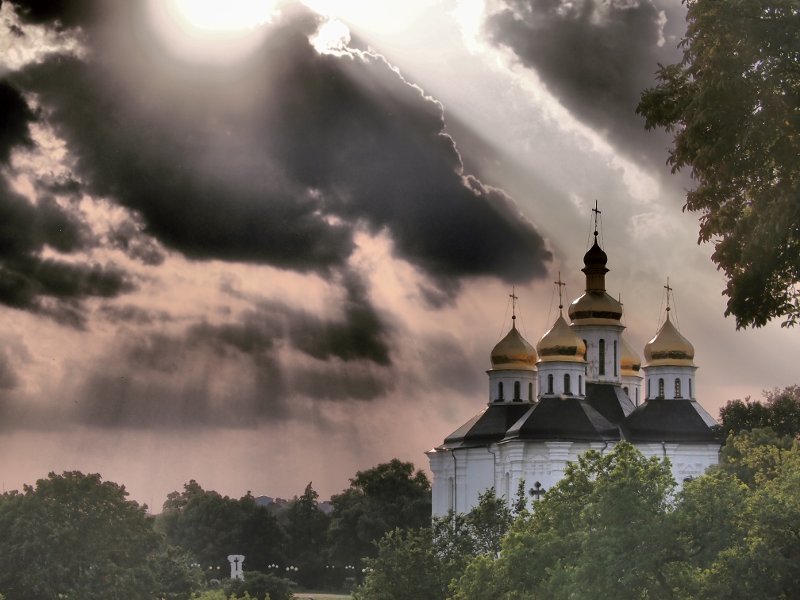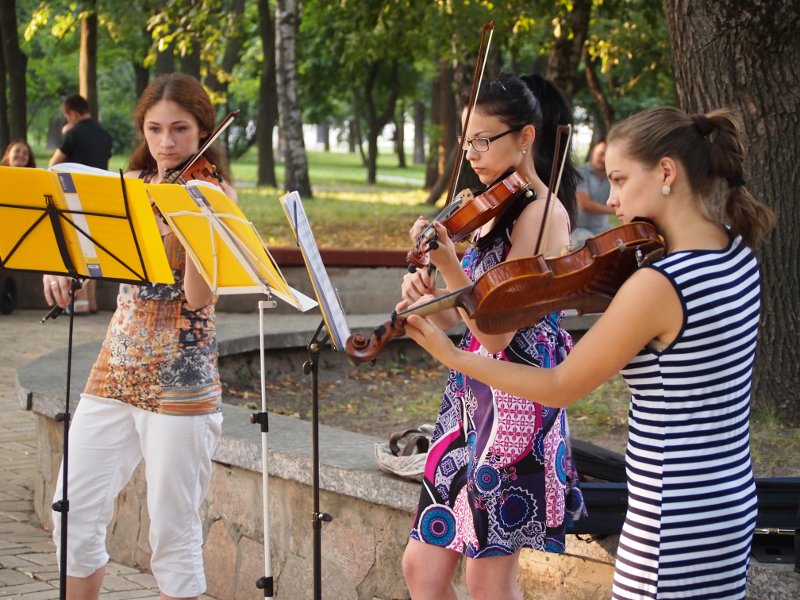
I'm back in the United States and mostly unjetlagged from a week in Ukraine, where I spent most of the time with the Chernihiv Media Group in a program operated by IREX and funded by the U.S. State Department. Ukraine is a country at war, but it's a strange one, geographically isolated to an eastern region where pro-Moscow rebels (and covert Russian soldiers) are trying to break away and reconnect with Russia.

The most striking thing about it all is how perfectly ordinary everything seemed. Ordinary in a good way. Ordinary in the sense of a peaceful European country trying to simply be a peaceful European country.
The recent history has been marked by upheaval: last year's Euromaidan Revolution that ousted a pro-Moscow president, the Orange Revolution a decade earlier, and efforts by Russia's preening strongman Vladimir Putin to break up the country into pieces he can use as he tries to reconstruct the glory days of the Soviet Union. It was only a year ago that a missile, believed to have been fired by Russians illegally in Ukraine, shot down Malaysian Airlines flight 17 over the Donbass region, killing 298 people. The State Department advises that travelers take care and avoid certain regions.
But the only signs we saw of all that were memorials here and there to the victims of the Euromaidan struggle, and a few booths set up to collect contributions to benefit soldiers injured in the fighting in the east.
Chernihiv is a quiet, walkable town of around 300,000 population about 50 miles from the border with Russia and maybe 30 to Belarus. Russian is the dominant language. The river Desna flows through the city, and before 7 a.m. babushkas (grandmothers) swam in the cool waters, singing folk tunes. On the river bank, smoke curled from the chimney of a rustic banya (sauna). Older men walked and exercised on a trail where younger bicyclists occasionally hustled by.
In central Chernihiv at Park Popudrenka, where a stern and domineering statue of Lenin once stood, there is a fountain whose illuminated jets dance to the beat of music. At 10 p.m., families clustered so their children could dance.
Our mission was a cultural exchange and professional development program, so we did have to do some work on this trip. Joe Fenton, metro editor of the Florida Times-Union, and I made presentations to and had discussions with the staff of Chernihiv Media Group.
The company has weekly printed newspapers, a regional classified advertising publication, radio stations and multiple websites in Chernihiv and other cities. We met with the print newsroom and digital staffs (which are separate), and with the advertising staff.
Translation services were provided by Olena Chapurna of IREX, who organized the exchange, and Oleksandra (Sasha) Zenchenko, a university teacher. I've worked with translators before, but never in such an interactive, conversational setting with small groups. They were so good that, as Joe said, it was easy to forget that we weren't all speaking the same language.
Right now the exchange rate between the U.S. dollar and Ukrainian hyrivnia is unusually favorable -- if you're an American, not so good if you're Ukrainian. The central bank stopped backing an artificial rate in February and the hyrivnia fell from 7 per dollar to more than 20 per dollar. As a result, an excellent "business lunch" of salad, okroshka (cold soup with dill), filet of fish and mashed potatoes came to $2.
Each day after our sessions with the CMG staff, we were treated to sightseeing and historical tours including the St. Anthony Caves, man-made caverns dug into a hillside by an Orthodox monk in the early 11th century. It is a cold, dark warren of tunnels and cells where ascetic monks were walled up in tiny holes to spend weeks in silent contemplation.
Above it all, in an oak forest, are hills containing graves dating back to periods of Viking invasions. In nearby fields and forests there are tens of thousands of more recent, shallow graves. They hold the defenders of Chernihiv, who were buried when the Nazis attacked in 1941 in the Great Patriotic War, or what we would call World War II. Much of Chernihiv was destroyed in the battle. The Germans built a fine new railway station, which still stands today, and headed to Moscow before the Russian winter of 1942 and the Red Army broke the Nazi advance.
During the Soviet era, churches were closed and turned into museums in some cases, storehouses in others. Most have been restored as working churches. The Chernihiv region is strongly onion-dome Orthodox, while in Kyiv there are the spires of Catholic churches, showing the influence of an era of Polish and Lithuanian dominance.
The Russian revolution, like the Mexican and French revolutions before it, identified the Church as a source of oppression, along with landowners and capitalists. Monks and priests were sent to camps, disappeared, or killed.
But they were not the only victims.
In the 1930s, Stalin's policies resulted in a mass famine in Ukraine that led to millions of deaths. Thousands were convicted of cannibalism. The famine is today regarded as an intentional, genocidal act intended to crush Ukrainian nationalism, but it was forbidden to even discuss it in the Soviet era, until Mihail Gorbachev introduced the policy of glasnost (openness) in the 1980s.
Three decades later, everything has changed, and many of today's adult Ukrainians have no memory of the Soviet times. American rock music plays on the radio. Restaurants are everywhere, even a McDonald's. The first floors of the apartment buidings on Prospekt Miru and Vulitsya Shevchenka are now occupied by commercial shops, where I bought a pair of sandals for the following day's river trip. They were made in Germany, and with the current exchange rate the proprietor will not be able to order replacements for the price I paid, under $15.
Our final day in Chernihiv was centered on a float trip down the Desna in a pontoon boat, featuring an excellent meal of smoked fish, potatoes with dill, and a tomato salsa, accompanied by growlers of excellent beer that we had bought the night before from a local microbrewery. All up and down the river, crowds of people were sunbathing, swimming, fishing, and enjoying banyas along the shoreline.
Friday we packed up and headed to Kyiv, the capital. It's 10 times the size of Chernihiv and 10 times as busy.
Friday night we gave a talk on free media at America House, a U.S. State Department cultural center in Kyiv. Behind fences and security scanners and ID checks we found room after room packed with Ukrainians learning video editing, 3D printer technology, salsa dancing and even a class in how to edit Wikipedia. Our talk was not so exciting as getting to play with a 3D printer, but the room was fairly full and the audience enthusiastic with questions.
There are no daily newspapers in the country, but Ukraine has seen an explosion of media options in print, broadcast, and Internet. The country is deeply troubled by corruption and needs strong, independent, professional journalism to expose it, but it seems that every oligarch feels a need to advance his interests by operating a publication, financing a politician, or both. The road to professional journalism in the United States was a long and troubled one and remains so today, We shouldn't expect Ukraine to conjure up honest and independent journalism overnight, but it was apparent from the questions that the passion and intent is there.
The U.S. government is funding a number of efforts to change Ukrainian culture in a more open and honest direction, including funding a program to hire new, professionally trained civilian police ("politsia") to replace the corrupt militsia that was involved in the Euromaidan struggle. These new police have become quite the selfie attraction for the local population -- that is, when they're not riding around in their modern new hybrid police cars.
Saturday was a day of sightseeing in the capital and visits to historic places -- and more evidence of the horrors of the Nazi invasion, but before that, the horrors of the Stalin era.
Our last museum visit commemorated a more modern tragedy: the Chernobyl explosion.
Chernobyl, when it opened, was the pride and joy of Soviet technology, a plant to deliver clean electrical power from the modern miracle of atomic energy.
But a moment of poor judgment during a systems test one Saturday morning led a fire and a series of explosions. Before it was brought under control, 31 people were dead, and -- once the Moscow government admitted there was a problem -- more than 350,000 people had to be evacuated. A plume of radioactive fallout swept across the western Soviet Union and into the Scandinavian countries. Today there is a 30-kilometer exclusion zone where 11 villages once stood. It still stands as the worst nuclear plant disaster in history.
The Chernobyl disaster changed the way many people thought about nuclear power, but also the way many thought about the Soviet bureaucracy. The disaster -- and the global response offering aid -- was one of many elements in the opening of Soviet society that eventually led to the dissolution of the Soviet state.
Life goes on, and people learn to smile again. It seems that everywhere I travel, I stumble across weddings, so I'll end this with one last image, a positive one.
